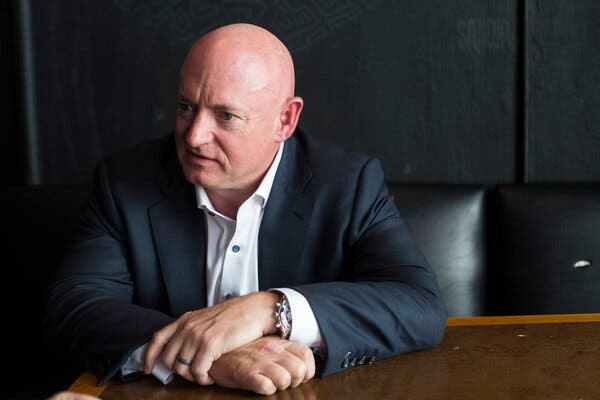Advertisement
Tom Steyer, the billionaire former investor, is an unlikely populist. But he is poised to be a deeply disruptive figure in the Democratic primary race.

DES MOINES — As Tom Steyer, the billionaire former hedge fund investor and impeachment impresario, made his first trip to Iowa as a 2020 candidate this month, he embarked on the usual political circuit.
He delivered a soapbox speech at the state fair (“We have to break the corporate stranglehold on our democracy,” he said), visited the butter cow (“Not my first butter cow,” he corrected one fairgoer; he had been there last year) and professed his desire to see farm animals.
What was unusual for a man who has never held elected office and who has been running for president for only a few weeks was that people kept recognizing him along the way.
“Hey, it’s the YouTube guy!” one woman shouted as Mr. Steyer strode past. He also heard from several fans of his TV ads, including Catherine Rondema of Portland, Ore., who said she liked his commercials so much that she had timed her Iowa fair visit to hear him speak.
Mr. Steyer has spent $12 million on digital and television ads in only six weeks — more than any other Democratic presidential candidate has spent all year.
Whether Mr. Steyer can become something more than the billionaire buying the ads about how “our democracy has been purchased” is an open question.
His barrage of the airwaves has allowed a political novice to accomplish something that far better known governors, senators and the mayor of America’s largest city have not: luring 130,000 donors and topping 2 percent in three polls, which puts Mr. Steyer one poll short of qualifying for the national debate stage next month. His fortune has allowed him to be a force in the race even as other Democrats — the two-term governors Jay Inslee of Washington and John Hickenlooper of Colorado in recent days — have had to call it quits.

White, male, wildly wealthy and, at 62, older than the next-generation candidates in the field, Mr. Steyer would seem an unlikely messenger for a Democratic Party that is passionately debating racial and gender diversity, generational change and inequalities in American society. But his status as a virtual one-man “super PAC” is already upending the carefully laid strategies of Democratic rivals who must now grapple with the fact that they are unlikely to have the airwaves to themselves.
Running as something of a patrician populist, Mr. Steyer brushed aside the dissonance of someone with his résumé — Exeter, Yale, Stanford, Morgan Stanley, Goldman Sachs — paying for ads that castigate the influence of “the powerful and well-connected.”
“I am the outsider in this race,” Mr. Steyer said in an interview. He described Senators Elizabeth Warren of Massachusetts and Bernie Sanders of Vermont as “part of the establishment” and asked whether the front-runner in the polls, former Vice President Joseph R. Biden Jr., really understood what this moment called for.
“The question really is for anybody running, including Vice President Biden, are you aware of how much has to change?” Mr. Steyer said, outlining a two-pronged agenda that would begin with rule changes to curb corporate power followed by significant action to address climate change. He has spent more than $7 million on television so far, according to ad trackers, concentrated in the early voting states of Iowa, New Hampshire, South Carolina and Nevada.
He has paid up to $10,000 for one 30-second broadcast spot in Boston, even though the New Hampshire voters he is targeting are a small fraction of the audience. No target audience appears too small. In Iowa, he is saturating viewers of Black Entertainment Television in Cedar Rapids seven day a week with spots as cheap as $11.
One tracking poll this week, from Morning Consult, which does not qualify him for the debate stage, showed him leaping to fifth place in the 21-candidate field, with 6 percent support in those four early states where most of his ads have aired.
His rivals have accused him of simply buying his way in. “The Democratic primary should not be decided by billionaires,” Ms. Warren said on Twitter the day Mr. Steyer entered the race.
Activists and Democratic officials have generally been muted in their criticism of a top party financier who has spent hundreds of millions of dollars in the past decade. Many privately acknowledged having received Mr. Steyer’s funds in the past and said hopes for his money in the future had kept them silent.
Amanda Litman, the executive director of Run for Something, which encourages Democrats to pursue local office, said that Mr. Steyer could spend his money however he wished but that it would “go a lot further toward making progress on his goals if he invested in state legislatures.”
“We don’t have as many billionaires as the G.O.P. does,” she said. “We need them all to be in the right fight.”
The Steyer campaign has floated a $100 million budget, which is more than the top five Democratic candidates — Mr. Biden, Mr. Sanders, Ms. Warren, Mayor Pete Buttigieg of South Bend, Ind., and Senator Kamala Harris of California — raised in the second quarter combined.
Mr. Steyer has already outspent his opponents online in a fraction of the time they have been running: pouring $1 million into Google and YouTube ads and $3.9 million on Facebook, peaking at $215,000 a day on the social network.
Mr. Steyer is adding to his ranks, too, hiring state directors in far-flung and often unstaffed states like Vermont, Utah, Alabama and Oklahoma.
If Mr. Steyer qualifies for the September debate before the deadline on Wednesday, he will be the 11th candidate and prevent all of the top contenders from sharing a stage, as the field will be split over two nights. If he falls short, he is on track to qualify for an October debate.
“You underestimate my brother at your peril,” said Jim Steyer, who is one year older. He said that when Tom Steyer was considering running for California governor or senator, Ms. Harris and Gavin Newsom, now the governor, would use him as a back channel to find out about his brother’s plans. “People like Gavin and Kamala, they were always afraid of Tom,” he said.
One big unknown is whether Mr. Steyer will use his financial might to obliterate his opponents with negative ads. Those who have worked with Mr. Steyer describe him as fiercely competitive and used to getting his way.
“He’s been thinking about this for a long time,” Gil Duran, a former Steyer adviser, said. “I don’t think there’s a limit on what he’ll do to try to reach this goal.”
Mr. Steyer himself said he would not rule out negative ads. “Look, there’s something I really care about doing, and I’m going to try really hard to do it,” he said.
Of course, Mr. Steyer’s own record at the company that made him rich, Farallon Capital Management, is likely to receive fresh scrutiny. The company has faced accusations of tax sheltering, and its investments in coal and private prisons could prove problematic. In the interview, he pledged to release his tax returns, though he would not commit to a date other than saying that it would happen before the Iowa caucuses in February.
For Mr. Steyer, his 2020 run is actually the culmination of a decade of political groundwork as he has reinvented himself from investor to political activist to candidate.
He has spent millions of dollars pressing for the impeachment of President Trump in ads that promoted himself and his group Need to Impeach, while building up an eight-million-strong email list (his campaign must technically rent the list, but that is little more than an accounting concern). And he constructed an environmental advocacy group, NextGen America, with nationwide chapters.
“He’s built an infrastructure that can be turned into working for a presidential campaign,” Kevin Mack, chief strategist for Need to Impeach, said.
Mr. Steyer has some experience in retail politicking, having fielded questions at town-hall-style events held by Need to Impeach across the country. Still, he can be stilted.
At the state fair, Mr. Steyer was pushed by an Iowa farmer, Kyle Gilchrist, about how a $15-an-hour minimum wage would work in rural areas. “I respect you’ve built a 37-million — billion — whatever it is,” Mr. Gilchrist said. “I’m a poor man from Van Buren County.” Mr. Gilchrist said he still baled hay himself. The billionaire lifted the farmer’s T-shirt sleeve to inspect his biceps, nodding in approval.
Mr. Steyer is not a self-funded politician in the centrist mold of Mayor Michael R. Bloomberg, the former mayor of New York. In some ways, Mr. Steyer is a liberal occupying the same structural reform space as the progressive leaders, Ms. Warren and Mr. Sanders. He has embraced decriminalizing the border and expanding the Supreme Court and, as a private citizen, proposed a “wealth tax” on assets of the superrich last fall, before Ms. Warren did.
“Virtually everybody else in this race, including those two senators, comes from D.C., is part of the establishment,” Mr. Steyer said. “So if you think the problem is broken government, which is what I think, if you think that the corporations have bought the government, who do you think is going to reform it? Do you think it’s going to be someone from the grass roots, from the outside, who’s done it for 10 years? Or do you think it’s going to be someone from D.C.?”
If the idea of a wealthy mogul running as an unbought outsider against a rigged system sounds familiar, that is no accident.
“Mr. Trump had a point,” Mr. Steyer said. “I think that’s why he got elected. Because the system is broken. It turns out he’s the biggest stooge there is.” Mr. Steyer’s ads have also argued that, as a billionaire, he has standing to take on Mr. Trump on the economy.
When Mr. Trump came to the Iowa State Fair in 2015, he arrived on his own private plane and brought along a helicopter for joy rides. Mr. Steyer says he only flies commercial for environmental reasons. He also refuses bottled water.
“Personal choice is not going to solve this problem,” he acknowledged, speaking of climate change.
His other personal choice — spending $100 million to try to be president — is why he found himself speeding across the Iowa fairgrounds in the early August heat to catch some 4-H farm animals before his scheduled commercial flight. He broke into a light jog as his son, staff members and a couple of journalists followed in a slow-motion chase.
“Run, Forrest, run,” someone shouted as Mr. Steyer pumped his arms.
His eyes widened when he learned that some Democrats flew private planes on the campaign trail. (“Are other people flying private?” “Like who?” “I’d love to know who’s flying private planes.” “How do you find that out?”)
“There’s a real question here about who takes climate seriously,” Mr. Steyer finally said. “It’s a real question.”
When Mr. Steyer arrived, the barn was empty. “Doggone it,” he muttered to no one in particular.
With that, he and his staff were off to the airport.
Shane Goldmacher is a national political reporter and was previously the chief political correspondent for the Metro Desk. Before joining The Times, he worked at Politico, where he covered national Republican politics and the 2016 presidential campaign. @ShaneGoldmacher



